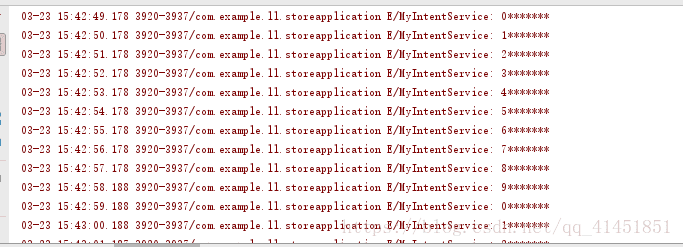一.Service有几种启动方式
Service有二种启动方式,一种就是我上次写的startService,另一种是bindService。下面将主要介绍bindService以及IntentService(一种新的类,并不是启动方式)。
二.startService的特点及优缺点
优点:startService使用简单,和Activity一样,只要几行代码就能启动Service。
缺点:startService无法获得Service对象,不能直接操作Service中的属性和方法,只能通过Intent传值,重复调用startService,触发onStartComment。
三.bindService的特点及优缺点
优点:可以得到Service对象,灵活控制Service内部的属性和方法。
缺点:使用方法复杂。
四.bindService使用实例
这里先介绍bindService方式
1.新建类继承Servic
2.重写onCreate方法
3.实现onBind方法
4.重写onUnBind方法
5.重写onDestroy方法
6.在AndroidManifest中注册Service
7.在有Context环境中实现ServiceConnection接口。
8.在有Context环境中通过bindService绑定Service。
9.在有Context环境中通过unbindService解绑Service。
代码展示
先创个类继承Service
package com.example.ll.storeapplication.store;
import android.app.Service;
import android.content.Intent;
import android.os.Binder;
import android.os.IBinder;
import android.support.annotation.Nullable;
import android.util.Log;
/**
* Created by ll on 2018/3/23.
*/
public class TextService extends Service{
private String Tag="TextService";
private Guanjia guanjia=new Guanjia();
public class Guanjia extends Binder{
//作用:得到当前Service对象
public TextService getServiceObject(){
return TextService.this;
}
}
public void fly(){
Log.e(Tag,"开飞机.......");
}
@Nullable
@Override
public IBinder onBind(Intent intent) {
Log.e(Tag,"onBind.......");
return guanjia;
}
@Override
public boolean onUnbind(Intent intent) {
Log.e(Tag,"onUnbind.......");
return super.onUnbind(intent);
}
@Override
public void onCreate() {
super.onCreate();
Log.e(Tag,"onCreate.......");
}
@Override
public void onDestroy() {
super.onDestroy();
Log.e(Tag,"onDestroy.......");
}
}
然后写xml界面
<?xml version="1.0" encoding="utf-8"?>
<LinearLayout xmlns:android="http://schemas.android.com/apk/res/android"
xmlns:app="http://schemas.android.com/apk/res-auto"
xmlns:tools="http://schemas.android.com/tools"
android:layout_width="match_parent"
android:layout_height="match_parent"
android:orientation="vertical"
tools:context="com.example.ll.storeapplication.ServiceActivity">
<Button
android:id="@+id/bindbtn"
android:layout_width="match_parent"
android:layout_height="50dp"
android:text="绑定SERVICE" />
<Button
android:id="@+id/jiebanbtn"
android:layout_width="match_parent"
android:layout_height="50dp"
android:text="解绑SERVICE" />
<Button
android:text="跳转B界面"
android:id="@+id/diaozhuan"
android:layout_width="match_parent"
android:layout_height="50dp" />
</LinearLayout>
最后在主要Activity写启动Service
package com.example.ll.storeapplication;
import android.content.ComponentName;
import android.content.Intent;
import android.content.ServiceConnection;
import android.os.IBinder;
import android.support.v7.app.AppCompatActivity;
import android.os.Bundle;
import android.view.View;
import android.widget.Button;
import com.example.ll.storeapplication.store.TextService;
public class ServiceActivity extends AppCompatActivity implements View.OnClickListener{
private Button jbbtn;
private Button bdbtn;
private Button tzbtn;
private ServiceConnection serviceConnection=new ServiceConnection() {
@Override
public void onServiceConnected(ComponentName componentName, IBinder iBinder) {
//通过管家的中介作用,拿到TextService对象
TextService textService=((TextService.Guanjia) iBinder).getServiceObject();
textService.fly();
}
@Override
public void onServiceDisconnected(ComponentName componentName) {
}
};
@Override
protected void onCreate(Bundle savedInstanceState) {
super.onCreate(savedInstanceState);
setContentView(R.layout.activity_service);
bindId();
}
private void bindId() {
jbbtn=findViewById(R.id.bindbtn);
bdbtn=findViewById(R.id.jiebanbtn);
jbbtn.setOnClickListener(this);
bdbtn.setOnClickListener(this);
tzbtn=findViewById(R.id.diaozhuan);
tzbtn.setOnClickListener(this);
}
@Override
public void onClick(View view) {
switch (view.getId()){
case R.id.bindbtn:
Intent intent=new Intent(this,TextService.class);
bindService(intent,serviceConnection,BIND_AUTO_CREATE);
break;
case R.id.jiebanbtn:
unbindService(serviceConnection);
break;
case R.id.diaozhuan:
Intent intent1=new Intent(this,BActivity.class);
startActivity(intent1);
break;
}
}
}
五.IntentService优点和缺点
优点:无需处理线程的创建与线程同步问题,无需手动关闭Service。
缺点:无法精准控制线程执行过程,一旦启动只能等待线程结束。
六.IntentService使用实例
首先了解IntentService的步骤
1.兴建类继承IntentService
2.实现父类的构造方法
3.重写onHandleIntent方法
4.重写onCreate方法
5.重写onDestroy方法
6.在在AndroidManifest中注册Service
7.在有Context环境中通过startService启动Service
代码展示
先创个类继承Service
package com.example.ll.storeapplication.store;
import android.app.IntentService;
import android.content.Intent;
import android.support.annotation.Nullable;
import android.util.Log;
/**
* Created by ll on 2018/3/23.
*/
public class MyIntentService extends IntentService {
public MyIntentService(String name) {
super(name);
}
public MyIntentService(){
super("");
}
@Override
protected void onHandleIntent(@Nullable Intent intent) {
for (int i=0;i<10;i++){
try {
Log.e("MyIntentService",i+"*******");
Thread.sleep(1000);
} catch (InterruptedException e) {
e.printStackTrace();
}
}
}
}
然后写xml界面
<?xml version="1.0" encoding="utf-8"?>
<LinearLayout xmlns:android="http://schemas.android.com/apk/res/android"
xmlns:app="http://schemas.android.com/apk/res-auto"
xmlns:tools="http://schemas.android.com/tools"
android:layout_width="match_parent"
android:layout_height="match_parent"
android:orientation="vertical"
tools:context="com.example.ll.storeapplication.IntentServiceActivity">
<Button
android:id="@+id/oepnbtn"
android:text="启动IntentService"
android:layout_width="match_parent"
android:layout_height="50dp" />
<Button
android:id="@+id/closebtn"
android:text="关闭IntentService"
android:layout_width="match_parent"
android:layout_height="50dp" />
</LinearLayout>
最后在主要Activity写启动Service
package com.example.ll.storeapplication;
import android.app.IntentService;
import android.content.Intent;
import android.support.v7.app.AppCompatActivity;
import android.os.Bundle;
import android.view.View;
import android.widget.Button;
import com.example.ll.storeapplication.store.MyIntentService;
public class IntentServiceActivity extends AppCompatActivity implements View.OnClickListener{
private Button openbtn;
private Button closebtn;
private Intent intent;
@Override
protected void onCreate(Bundle savedInstanceState) {
super.onCreate(savedInstanceState);
setContentView(R.layout.activity_intent_service);
bindId();
}
private void bindId() {
openbtn=findViewById(R.id.oepnbtn);
closebtn=findViewById(R.id.closebtn);
openbtn.setOnClickListener(this);
closebtn.setOnClickListener(this);
}
@Override
public void onClick(View view) {
switch (view.getId()){
case R.id.oepnbtn:
intent=new Intent(this, MyIntentService.class);
startService(intent);
break;
case R.id.closebtn:
stopService(intent);
break;
}
}
}
最后完成一个读秒操作如下图

七.IntentService和Service区别
IntentService与Service最大的区别是IntentService本身自带子线程,而Service需要调用Thread方法构造子线程。所以IntentService可以直接进行耗时操作,而Service不能进行耗时操作,因为Service并不是个线程。





 本文详细介绍了Android中的Service启动方式,重点讲解了bindService的特点、使用步骤,以及IntentService的优势和使用实例。bindService允许直接操作Service对象,但使用较复杂;IntentService简化了线程管理,适合进行耗时操作,但无法精确控制执行流程。
本文详细介绍了Android中的Service启动方式,重点讲解了bindService的特点、使用步骤,以及IntentService的优势和使用实例。bindService允许直接操作Service对象,但使用较复杂;IntentService简化了线程管理,适合进行耗时操作,但无法精确控制执行流程。

















 被折叠的 条评论
为什么被折叠?
被折叠的 条评论
为什么被折叠?








